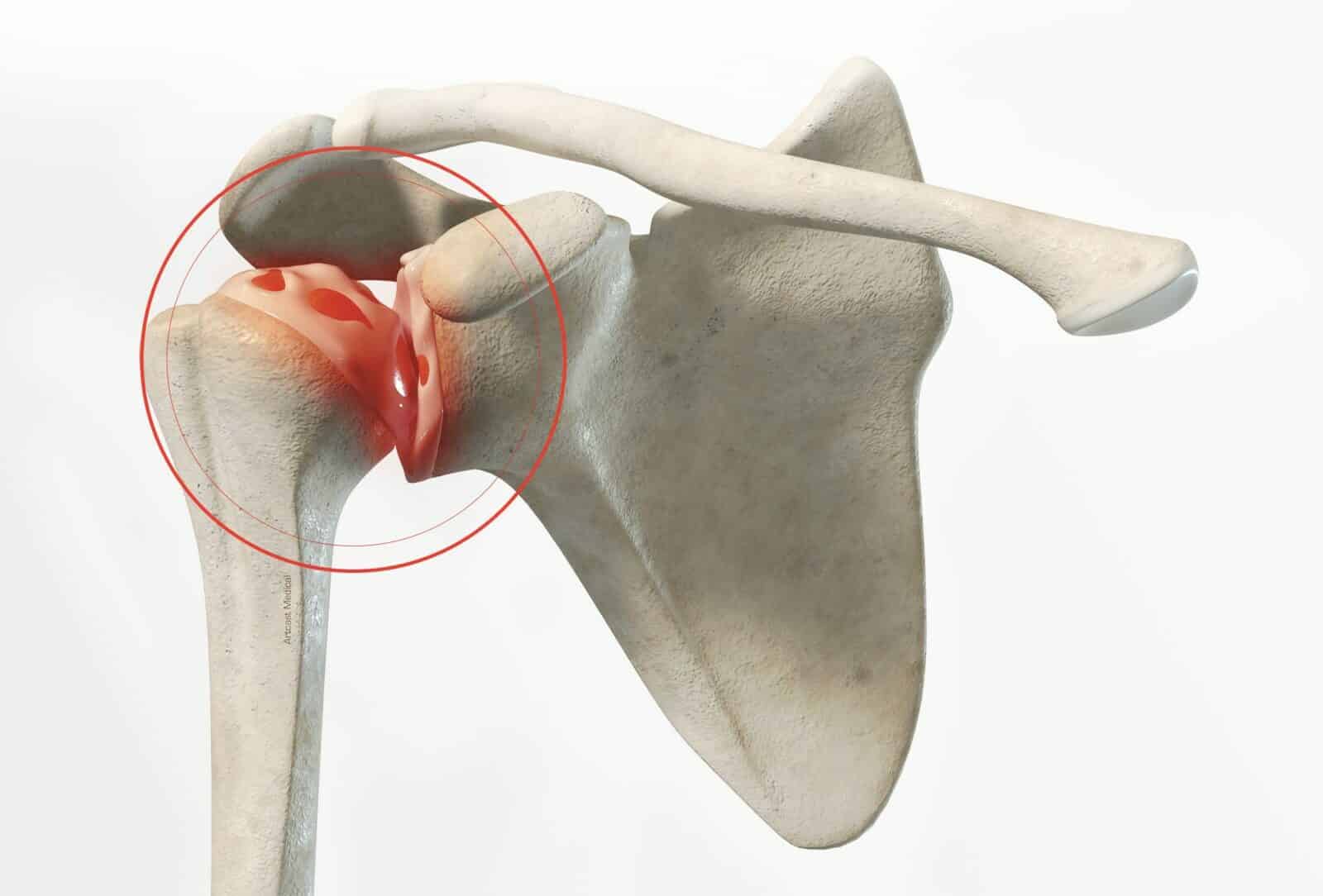Total shoulder replacement
You have shoulder osteoarthritis
You are going to undergo total shoulder replacement

You have shoulder osteoarthritis
You are going to undergo total shoulder replacement
Total shoulder replacement
The shoulder is the joint between the scapula and the humerus. The superior part of the humerus comprises a head that pivots in the glenoid cavity of the scapula (figure 1), and the sliding surfaces are lined with cartilage.
The deltoid muscle and the shoulder tendons surround the joint. They are attached to the head of the humerus and participate in the lifting movements of the arm and rotation of the shoulder.
Osteoarthritis is the wear and tear of the cartilage on the sliding surfaces. This wear and tear is also accompanied by modifications of the humerus and the scapula (figure 2, photo 1).
These modifications cause pain and a decrease in mobility, as well as difficulty in using the arm, and require the heavy use of anti-inflammatories and painkillers.

The wear of the cartilage is irreversible and osteoarthritis does not heal spontaneously. The natural progression is the gradual deterioration of the joint, with increasingly limited mobility and increased difficulty in using the arm. The anti-inflammatories and painkillers that were enough to start with are no longer effective, and so the question of the need for surgery is raised.
The objective of the operation is to relieve the pain, recover joint mobility and normal use of the arm.
The objective of shoulder replacement is to remove the areas of bone and cartilage that are worn, and to replace them with artificial parts of the same shape.
A short incision is made in the anterior part of the shoulder. The various muscles are moved aside to access the joint. The head of the humerus is removed (figure 3), then the humeral bone (figure 4) and the glenoid cavity (figure 5) are prepared to receive the implant.

The implant comprises two components :
The glenoid cavity, which is the socket attached to the scapula, and the stem with the ball, which is attached to the humerus. The ball replaces the head of the humerus and articulates with the glenoid cavity (figure 6, photo 2). This is a standard total shoulder implant, and requires all the tendons in the shoulder to be spared.

If the tendons are ruptured, the correct functioning of the joint cannot be restored with this type of implant. A reverse shoulder replacement can be used in older patients: the ball is located on the scapular and the socket on the humerus (figure 7, photo 3). The shape of this implant enables the deltoid muscle, which is present and functional in most cases, to be used and which replaces the ruptured tendons.

The operation lasts about one and a half hours, and requires around 5 days in hospital.
Total shoulder replacement is often carried out under general anaesthesia, although it can be combined with a regional anaesthetic. Your anaesthesiologist will decide with you the best type of anaesthesia according to your state of health.
After the operation, the incisions are covered with a sterile dressing, which is left in place for 15 days. The pain will be managed and monitored very closely during the post-operative period, and the treatment will be adjusted accordingly. You will wear a brace to immobilize and protect your shoulder.
The day after the operation, the physiotherapist will get you up and help you move your shoulder. You will progressively abandon the brace. When you leave the clinic, the rehabilitation, of which the aim is to recover active mobility and muscle strength in the shoulder, can be carried out at a centre or at your physiotherapist’s.
Driving can be envisaged after the 2nd month, and you can generally return to work after the 3rd month, depending on your profession; office work can be sooner. You can generally return to sports activities between the 2nd and 4th month, depending on the sport.
In addition to the risks associated with any surgery and the anaesthetic, there are some risks specific to this surgery :
This list of risks is not exhaustive. Your surgeon can provide you with any additional explanations and will be available to discuss the advantages, disadvantages and risks of each specific case with you.
The results of this technique are very encouraging as an often spectacular disappearance of the pain and a rapid recovery of mobility are observed. Good use of the arm is generally recovered within two months post-op. In general, 80 to 90 % of normal function is recovered for a standard replacement and 60 to 70 % for a reverse replacement.
Even if you can resume daily activities, it is preferable to avoid physical work and violent sports, as these activities can increase the wear and decrease the lifespan of the prosthesis despite the use of new, more resistant materials. Some activities that only put a little strain on the shoulder, such as jogging, swimming, or walking, are possible, and even recommended, whereas care should be taken with tennis, golf and bowling.
The average lifespan is about 20 years for a standard replacement and 10 to 15 years for a reverse replacement. With the progress in the materials used today, we hope that the results and the longevity will continue to improve.
Laissez votre commentaire